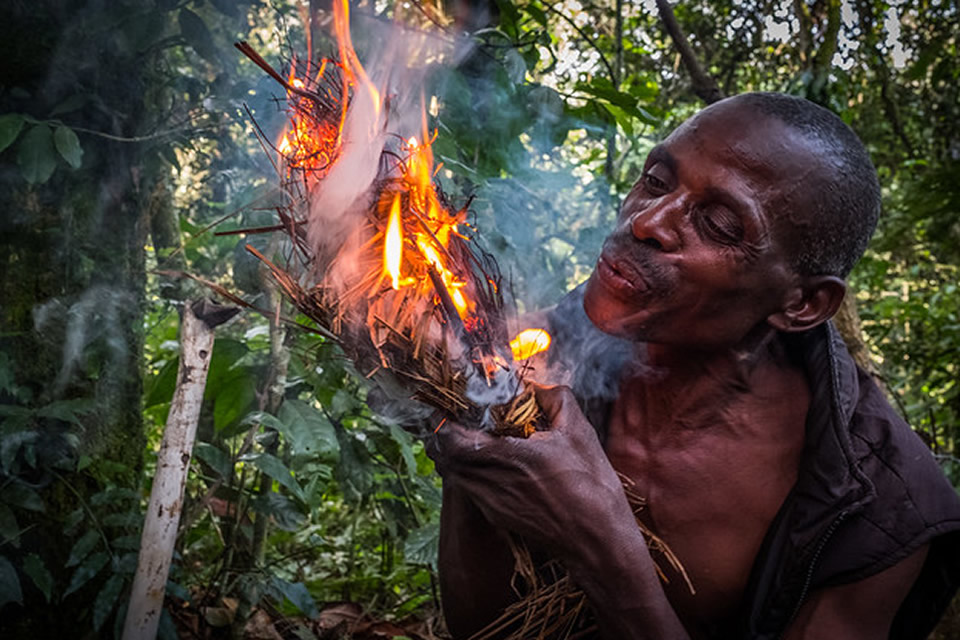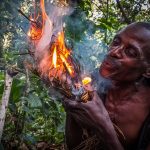A group of indigenous Pygmoids or Twa people live in many parts of central and eastern Africa. In Uganda, they include the Bambuti in Kasese region at the foot of the Rwenzori mountain chain as well as the Batwa in the neighboring communities of Bwindi and Mgahinga forests.
The tropical rain forests of subsaharan Africa are incredibly lush environments with trees forming a canopy of 100 to 200 feet of different layers in air and spongy like grounds with undergrowth supporting the vast array of wildlife species found no where else on the planet. This region is a home to mammals, birds and plants, some endemic to the Albertine Rift. The Albertine Rift expands over large parts of eastern Africa. Some of them are the Virunga massif i.e Mgahinga Gorilla National Park, Volcanoes National Park and Virunga National Park and Bwindi Impenetrable National Park which habits half of the worlds remaining mountain gorillas along with the indigenous people.
Facts About the Batwa:
The batwa prefer being called by their given names e.g Kanyihamba, Kaca Ntare. These names are all relating to life in the jungle, they are names of wildlife species, or even preffered meals or what happened exactly during birth. An individual born during the famine period is called Nyanjara which translates to “a period without food”. The name Pygmy referres to the ancient dwellers of the forest who were and still are locally termed as Omutwa, Twa, or Omunyihamba. The first record of Pygmies were made by the Egyptians over 4000 years ago who described short stature people living near the mountains of the moon with unique abilities as dancers and story tellers both about the forest as their main theme. Both the Pygmies and the recent inhabitants of the last 600 years (Bantu) believe the Pygmies to be the very first inhabitants of the forest.
Daily Life in the Jungle:
Feeding: They survived by hunting small game using poison tipped arrows or nets, gathering various plants and fruits that the forest naturally provided for them.
Shelter: Small temporary huts made out of leaves and branches were used as their dwellings. They are then abandoned after a few days, weeks, or months as they relocate to another part of the forests. This was done in search of other forest supplies like food, in case of an epidemic disease like measles, disagreements within the community, and conflicts.
Tools: These remarkably remain very basic. For example, sharpened sticks for digging and cutting, fire hardened arrow tips, sharpened wood, and an iron knife for slushing the underbrush were used. Today, they can be seen at Nkuringo Cultural Centre’s Batwa museum in Rubuguri, or with today’s Batwa communities.
The Batwa Today:
Whereas most forests here like Bwindi Impenetrable National Park was closed entitled a a national park and a world heritage site by UNESCO in 1992 to protect the very low number of mountain gorillas present at that time,it was good news for the gorilla conservation mission but bad news for the Batwa. They were made to leave the forests and their entire heritage behind and join the existed Bantu farming families around. This was and still is one of today’s social, economical and political challenge in the region. Today, there are Batwa children in the education sector learning together with the Bantu in the same schools, classes as well as a small number of marriages between Batwa and Bantu people. One of Instinct Safaris’ missions is to improve the situation for the Batwa and to facilitate a dialog between the cultures which were originally forced to merge. We try to do as much as we can to keep the Batwa traditions in everyday life.
Instinct Safaris and the Batwa – Perspectives:
Uganda is not only a place where you go for wildlife encounters but it is a place where you can get the experience in exploring cultures and ways of life. The original conservation stake holders living in harmony with nature were the Batwa. Enjoy a Batwa forest experience, a community walk, or learn from the Batwa as we negotiate to visit a Batwa family home.With Instinct Safaris you are introduced to this extraordinary adventure in the Pearl of Africa for ancient stories, myths, singing folk tales, dancing and reciting riddles of which revolve around life in the forest. We tailor itineraries to experience seeing the forest through the eyes of the first people. On our walking safaris to various locations around Kisoro, Lake Mutanda, and Bwindi, Batwa community members are a part of the community guiding team.


